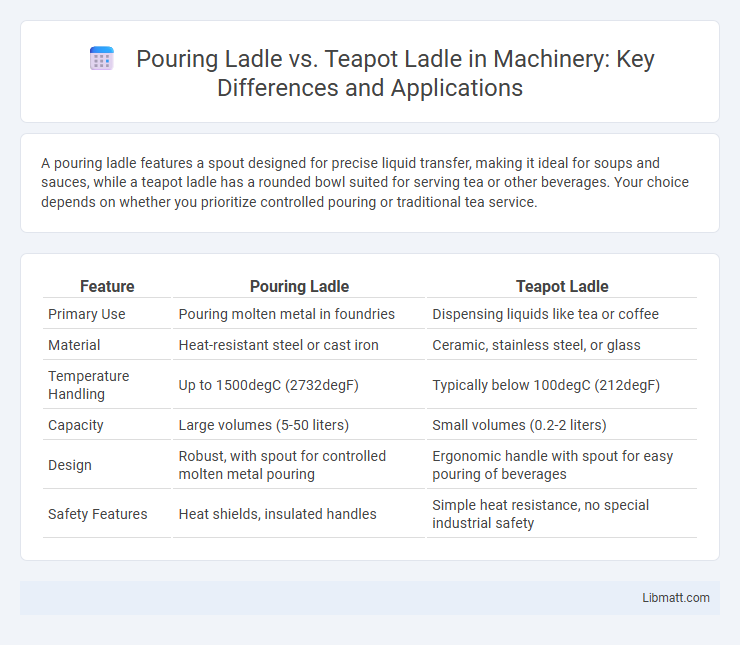A pouring ladle features a spout designed for precise liquid transfer, making it ideal for soups and sauces, while a teapot ladle has a rounded bowl suited for serving tea or other beverages. Your choice depends on whether you prioritize controlled pouring or traditional tea service.
Table of Comparison
| Feature | Pouring Ladle | Teapot Ladle |
|---|---|---|
| Primary Use | Pouring molten metal in foundries | Dispensing liquids like tea or coffee |
| Material | Heat-resistant steel or cast iron | Ceramic, stainless steel, or glass |
| Temperature Handling | Up to 1500degC (2732degF) | Typically below 100degC (212degF) |
| Capacity | Large volumes (5-50 liters) | Small volumes (0.2-2 liters) |
| Design | Robust, with spout for controlled molten metal pouring | Ergonomic handle with spout for easy pouring of beverages |
| Safety Features | Heat shields, insulated handles | Simple heat resistance, no special industrial safety |
Introduction to Ladles in Metal Casting
Pouring ladles and teapot ladles serve distinct functions in metal casting, with pouring ladles designed for transferring molten metal from a furnace to a mold, featuring sturdy, heat-resistant materials and a spout for controlled flow. Teapot ladles, shaped similarly to a teapot with a spout and handle, are used for more precise pouring tasks and small-scale casting operations, allowing better control over the molten metal's direction. Your choice of ladle impacts the efficiency and safety of the casting process, depending on the volume of metal and precision required.
Defining Pouring Ladle and Teapot Ladle
A pouring ladle is a specialized kitchen tool designed with a deep bowl and a spout to facilitate precise transfer of liquids like soup or sauce without spilling. A teapot ladle, typically smaller and more rounded, is specifically crafted to serve tea by easily scooping and pouring hot water or brewed tea into cups. Both ladles differ in shape and purpose, with the pouring ladle optimized for controlled liquid transfer in cooking and the teapot ladle tailored for ceremonial or everyday tea serving.
Structural Design Differences
Pouring ladles feature a deep, narrow bowl with a spout designed for precise liquid transfer, while teapot ladles have a wider, more rounded bowl optimized for scooping and serving thicker liquids like tea leaves or broth. The handle of a pouring ladle is typically longer and angled to facilitate controlled pouring without spills, whereas teapot ladles often have shorter, straighter handles for ease of dipping and stirring. Materials also vary, with pouring ladles often made from heat-resistant metals and teapot ladles crafted from ceramics or porcelain to complement traditional tea sets.
Functionality and Pouring Mechanisms
Pouring ladles feature a deep bowl and a spout designed for controlled, precise pouring of liquids, making them ideal for sauces and gravies. Teapot ladles have a wider, rounder bowl and often include a mesh strainer to facilitate smooth pouring of tea while filtering out leaves. The key difference lies in the pouring mechanism: pouring ladles prioritize spill-proof flow, whereas teapot ladles focus on filtration and ease of serving brewed beverages.
Advantages of Pouring Ladles
Pouring ladles offer precise control over liquid distribution, reducing spills and waste during cooking or serving. Their elongated spout design enables targeted pouring, making them ideal for tasks requiring accuracy such as glazing or drizzling sauces. Made from durable materials, pouring ladles often provide enhanced heat resistance and ergonomic grips for improved handling and safety.
Benefits of Teapot Ladles
Teapot ladles offer precise control and ease of pouring due to their elongated spout and ergonomic handle, minimizing spills and enhancing serving accuracy. Their design facilitates a steady, controlled flow of liquids, making them ideal for delicate beverages or sauces. Crafted from heat-resistant materials, teapot ladles improve safety by reducing the risk of burns during transfer.
Applications and Suitable Use Cases
Pouring ladles, designed with a precise spout, are ideal for controlled pouring of liquids such as sauces, gravies, and dressings in professional kitchens and catering environments. Teapot ladles, featuring a wider, rounded bowl and ergonomic handle, are suited for serving beverages like tea or herbal infusions, ensuring smooth transfer without spills. Choosing between these ladles depends on the viscosity of the liquid and the need for precision versus volume in pouring tasks.
Safety Considerations in Ladle Selection
Choosing between a pouring ladle and a teapot ladle impacts safety protocols in industrial and kitchen settings. Pouring ladles, designed with spouts and heat-resistant handles, minimize spill risks when handling molten metal or hot liquids, reducing burn hazards. Teapot ladles, often heavier and lacking precise spouts, require careful handling to prevent accidents, making pouring ladles a safer choice for hazardous or high-temperature applications.
Cost and Maintenance Factors
Pouring ladles generally cost less upfront compared to teapot ladles due to simpler design and materials, making them a budget-friendly option for most kitchens. Maintenance for pouring ladles is straightforward, often requiring just regular cleaning without special care, whereas teapot ladles, crafted with delicate spouts or ornate handles, may demand more careful handling and occasional repairs that increase long-term costs. Your choice should factor in these cost and maintenance differences to ensure both functionality and economic efficiency in your kitchen tools.
Choosing the Right Ladle for Your Foundry
Selecting the right ladle for your foundry depends on the specific pouring requirements and metal types. Pouring ladles are designed for handling larger volumes and higher temperatures, making them ideal for melting and transferring molten metal in industrial settings. Teapot ladles offer precision and control during pouring, helping you achieve accurate metal placement in detailed casting operations.
Pouring ladle vs teapot ladle Infographic

 libmatt.com
libmatt.com